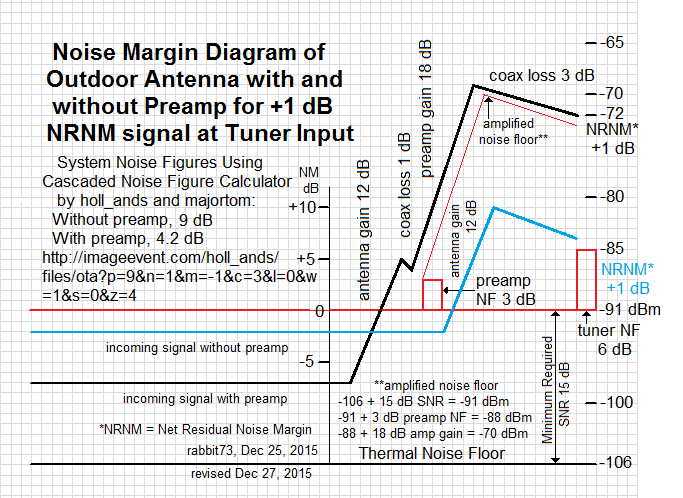Quote:
Originally Posted by JoeAZ

Is this information
correct or am I misunderstanding???
|
I see that ADTech posted while I was eating dinner, but I'll also give my answer to your question, since I already did the draft.
Your general rules are correct, but every reception location is unique.
Yes, attic loss is difficult to predict; it can be very high or minimal.
Yes, a preamp, if needed, should be as close to the antenna as possible, because it primarily determines the System Noise Figure which is expressed in dB (lower is better). And, as you have said, try the antenna first without a preamp.
Yes, a preamp will make the signals stronger to offset distribution losses.
Yes, if you are using a preamp and want to split, try a passive splitter first before adding a distribution amp. Both are rarely needed.
Quote:
I have ALWAYS understood that an amplifier, preamplifier,
or similar does nothing to increase the ability of the antenna
to receive signals......I do not understand the need for any amplification with short cable runs except for possibly a distribution amp
|
But, there are cases where a preamp can make it possible to receive weaker signals with a more negative NM, because the Noise Figure of the tuner is buried in the amplified noise floor, making it irrelevant.
The Noise Margin calculation of the tvfool report assumes that a preamp will be used, which means that a signal must be at least -91 dBm signal power for a NM of 0 dB. If you look at a tvfool report you will will see that there is a constant difference of 91 dB between the NM and dBm signal power.
This is where the -91 dBm comes from:
The Thermal Noise Floor for a DTV signal is -106 dBm (-15 dB NM). Any signal that is weaker can not be received; an antenna with more gain can not "pull it out of the noise." If you are able to receive a signal with a NM less than -15 dB, either the tvfool report is wrong or the signal has been enhanced by Tropospheric Propagation.
To that you must add the minimum required SNR of 15 dB:
-106 dBm + 15 dB = -91 dBm, before allowing for the preamp Noise Figure
If you do not use a preamp, then you have to add the tuner Noise Figure which is 6 dB average:
-106 dBm + 15 dB + 6 dB = -85 dBm; which is where most tuners will drop out
What is going on is that the antenna gain must make the signal strong enough to allow for the minimum required SNR of 15 dB and the Noise Figure of the preamp. Once the signal is strong enough for the preamp input, it will compensate for the distribution losses and bury the tuner Noise Figure in the much stronger amplified Thermal Noise Floor.
In the case where no preamp is being used, the antenna gain must make the signal strong enough to allow for the distribution losses and the tuner Noise Figure.
Maybe a few diagrams will help.
Indoor or attic, with and without a preamp:

Outdoor, with and without a preamp:

You can see how damaging attic/indoor loss is, You can also see how a preamp makes it possible to receive weaker signals, by about 5 dB.
This is what a System Noise Figure calculation looks like with and without a preamp.


reducing coax loss between antenna and preamp:

The main limiting factor when using a preamp to receive weak signals, is the strength of the local strong signals that might overload the preamp or tuner. Even a partial overload can create IMD (Intermodulation Distortion) that can damage the weak signals.
In this particular case, WPXA ION is the strongest signal with a signal power of -33.7 dBm, Fortunately, when a directional antenna is aimed 114 degrees, WPXA will be weaker because of the antenna pattern.

